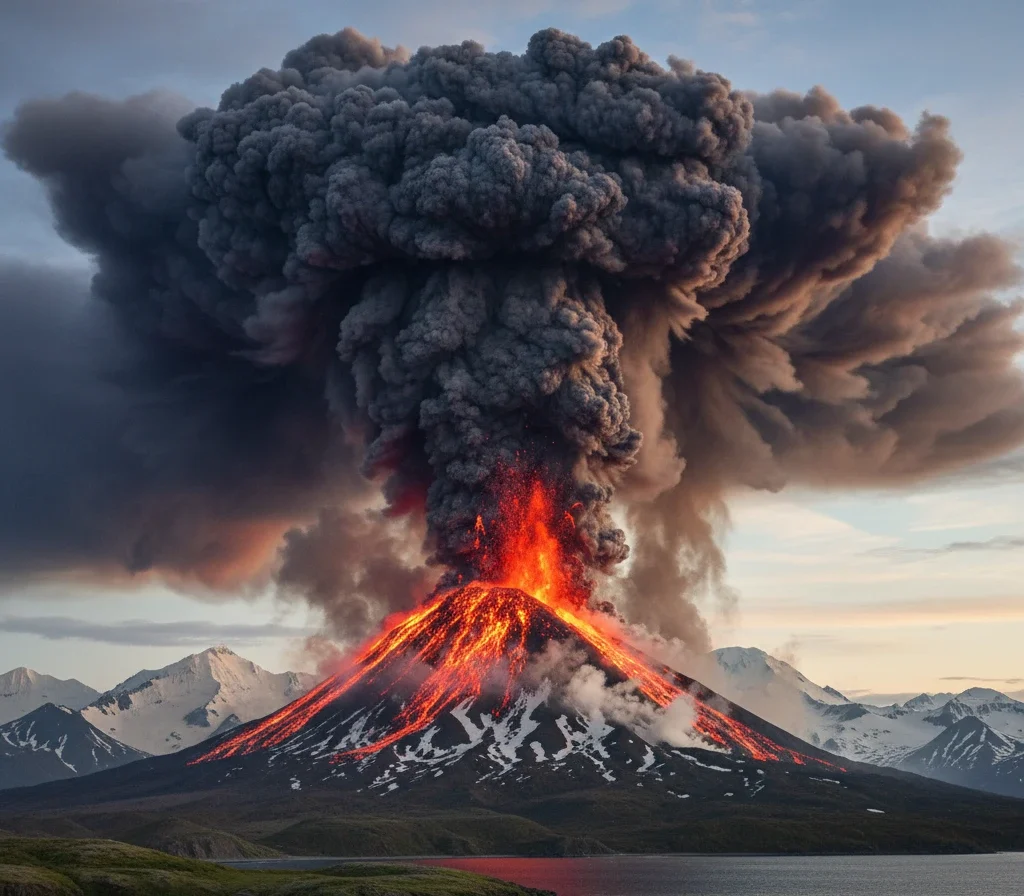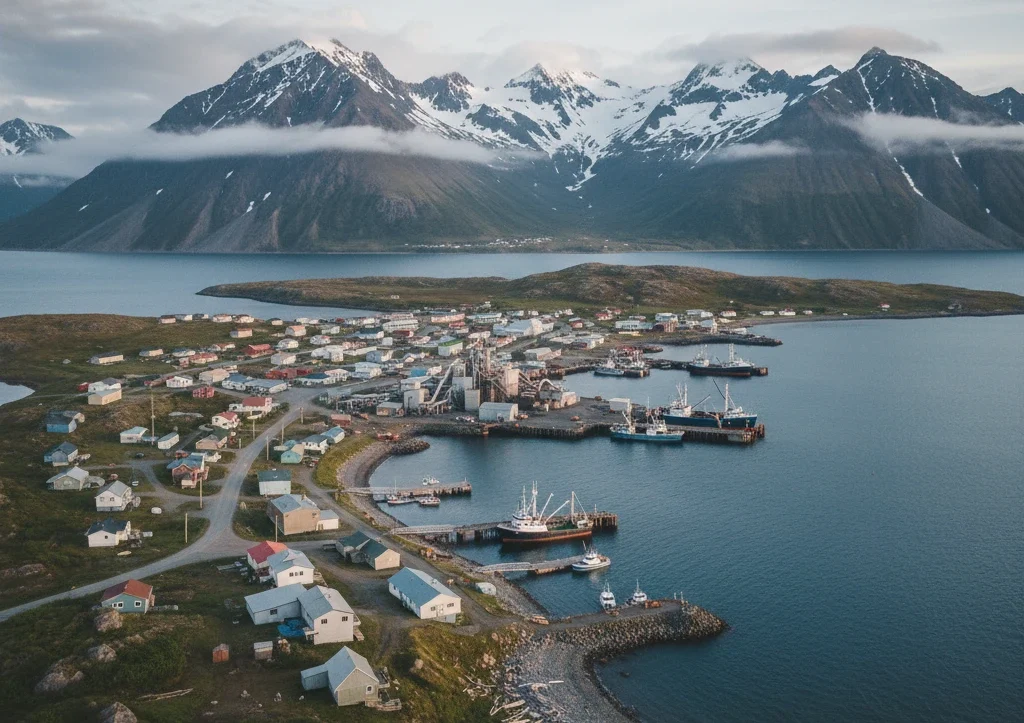Akutan is a small city on Akutan Island in the Aleutians East Borough, about 35 miles east of Unalaska (Dutch Harbor) and roughly 766 air miles southwest of Anchorage. Built mainly on boardwalks because of steep, wet terrain, Akutan supports one of Alaska’s busiest seafood-processing hubs and an active volcano monitored year-round by scientists.
Where Is Akutan, Alaska, Located? Geography and Setting
Akutan lies within the Fox Islands group of the Aleutian volcanic arc, part of the Alaska Maritime National Wildlife Refuge.
The island spans approximately 19 square miles of rugged volcanic ridges and coastal cliffs.
Because the terrain is steep and muddy, residents travel along elevated wooden boardwalks that connect homes, the harbor, and public facilities year-round.
Akutan Quick Facts (2025)
| Category | Latest Data (2025) | Source |
| Location | Aleutians East Borough, Alaska | AEB Gov 2025 |
| Coordinates | 54.135° N 165.775° W | USGS |
| Population Estimate | 1,587 | World Population Review 2025 |
| Area | ≈ 19 sq mi (land + water) | U.S. Census Bureau |
| Elevation Range | 0 – 4,275 ft (Akutan Volcano) | USGS |
| Climate Type | Sub-polar maritime | NOAA Climate Data 2025 |
| Average Temperature | 22 °F – 52 °F (–6 °C – 11 °C) | NOAA |
| Incorporated | 1979 (Second-Class City) | City of Akutan |
| Primary Industry | Fishing and Seafood Processing | AEB Economic Report 2025 |
| Local Tax | 1.5 % Fish Sales Tax | City Finance Dept 2025 |
Is Akutan Volcano Still Active? Eruption History and Geothermal Potential

The Akutan Volcano rises 4,275 ft (1,303 m) and remains one of Alaska’s most active stratovolcanoes.
According to the Alaska Volcano Observatory (AVO, 2025), it is currently at “Normal / Green” alert level, low unrest but ongoing fumarolic and steam-vent activity. More than 20 historical eruptions have been recorded since 1790.
Scientific Monitoring (2025)
- Continuous seismic and satellite surveillance by AVO.
- Gas emission and ground-deformation sensors confirm shallow geothermal heat.
- Hot Springs Bay Valley registers vent temperatures above 90 °C.
- The Alaska Division of Geological & Geophysical Surveys (DGGS) estimates that geothermal conversion could meet 30–35 % of local energy demand by 2030.
Akutan illustrates Alaska’s dual challenge: managing volcanic risk while pursuing clean-energy independence.
What Is the Population of Akutan in 2025?
Population data from World Population Review (2025) indicate a stable community, dominated by a transient working-age labor force supporting seafood processing.
| Indicator | Figure (2025) | Context |
| Population | 1,587 | WPR 2025 – steady since 2020 |
| Gender Ratio | ≈ 76 % male / 24 % female | Reflects seasonal workforce |
| Median Age | 40 yrs | Working-age majority |
| Foreign-Born Residents | ≈ 60 % | ACS 2024 Estimate |
| Median Household Income | $27,500 | ACS 2024 (affected by seasonality) |
| Mean Household Income | $46,139 | Over time boosted average |
| Median Family Income | $58,125 | Dual-earner families |
| Per-Capita Income | $38,144 | Above rural Alaska avg. |
| Poverty Rate | 17.4 % | Above state average (11 %) |
Permanent residents include long-term Unangan (Aleut) families, city employees, and support staff for Trident Seafoods.
What Is the Climate Like in Akutan?

Akutan’s subpolar maritime climate brings mild winters, cool summers, and persistent fog.
NOAA 2025 reports an annual precipitation average of 81 in (2,057 mm) and fog on more than 200 days each year.
| Season | Average Temp (°F) | Typical Conditions |
| Winter (Dec–Mar) | 22 – 30 | Snow; NW winds up to 60 mph |
| Spring (Apr–May) | 35 – 45 | Frequent fog and rain |
| Summer (Jun–Aug) | 48 – 52 | Cloudy; strong winds |
| Autumn (Sep–Nov) | 38 – 46 | Heavy rain; short daylight |
Because of near-constant storms, residents plan flights and barge shipments around weather windows.
How Does the Fishing Industry Drive Akutan’s Economy in 2025?
The Trident Seafoods Akutan plant anchors both the local and regional economy.
It remains one of the largest seafood-processing facilities in North America, directly employing more than 1,400 workers in 2025.
Core Industry and Employment Data
| Metric | Data (2025) | Context |
| Processing Capacity | > 3 million lbs of raw fish per day | Multi-species operation |
| Peak Employment | ≈ 1,400–1,450 workers | Exceeds the resident population |
| Workforce Composition | Predominantly seasonal and foreign-born | Rotational labor |
| Primary Species | Pollock, cod, king & snow crab, halibut, sablefish | Includes surimi, fishmeal, and fish oil |
| Plant Operation | 24-hour shifts in peak seasons | Pollock seasons Jan–Apr / Jun–Oct |
Economic Output and Tax Revenue (2025)
| Tax Type | Rate | Beneficiary | Notes |
| Borough Raw Fish Tax | 2 % | Aleutians East Borough | Applied to raw seafood sales (AEB Finance 2025) |
| City Fish Sales Tax | 1.5 % | City of Akutan | Funds local services & harbor maintenance |
Combined, these taxes generate most of Akutan’s municipal income.
No separate retail or property tax is currently levied.
Statewide Market Context (ADF&G 2025)
| Category | Figure (2025) | Trend |
| Commercial Salmon Harvest | 194.8 M fish | + 88 % vs 2024 |
| Total Weight | 793 M lbs | Statewide catch |
| Total Value | $541 M | Sockeye 58 % of value |
| Projected Harvest | 214.6 M fish | Slightly below forecast |
Akutan’s processing share represents a major portion of the Aleutians East Borough output, especially in pollock and crab.
How Do You Get to Akutan in 2025?
Akutan has no road connection to mainland Alaska. All access is by air and sea.
Current Transport Chain (2025):
- Anchorage → Unalaska (Dutch Harbor) scheduled service via Ravn Alaska or Alaska Airlines.
- Unalaska → Akun Island Airport (KQA) charter flights operated by Grant Aviation.
- Akun Island → Akutan City 6-mile transfer by Maritime Helicopters, contracted through the Aleutians East Borough.
Freight and supplies arrive by barge from Unalaska or Sand Point. Severe weather regularly delays travel.
What Is Daily Life and Governance Like in Akutan?
Akutan follows a mayor–council form of government. Seven elected members manage city services funded primarily by the 1.5 % fish tax.
The community’s cultural heart remains the St. Alexander Nevsky Russian Orthodox Church, a symbol of the region’s Unangan and Russian heritage.
Essential Infrastructure (2025)
- K–12 school (~25 students) Alaska State District Report 2025
- Clinic with telemedicine links to Anchorage
- Harbor & boat yard handling vessels to 165 ft (USACE spec 2024)
- Volunteer fire service and public works team
- Broadband via Starlink and GCI LTE (activated 2024)
Residents coordinate supplies jointly and depend on marine deliveries for food and fuel.
What Wildlife and Environmental Trends Define Akutan Island?
Akutan’s coastal ecosystem hosts rich marine and bird life typical of the Aleutian chain.
NOAA 2025 Ecosystem Status Report notes a 0.9 °C increase in Bering Sea surface temperature since 2000, affecting fish migration and sea-lion distribution.
| Group | Representative Species | Observation (2025) |
| Marine Life | Pollock, halibut, crab, Steller sea lion | Stable stocks (NOAA 2025) |
| Birds | Puffin, murre, whiskered auklet | Auklet endemic to Akutan cliffs |
| Land Animals | Arctic fox (only) | No bear population recorded |
Can You Visit Akutan? Tourism and Research Travel in 2025
Tourism remains limited but slowly growing among scientists and eco-travelers.
Visitors require permits from the Aleutians East Borough for research or drone operations near volcanic zones.
Visitor Guidelines (2025):
- Best Time: May – September (long daylight, milder weather).
- Activities: Guided volcano hikes, bird-watching, and marine photography.
- Access: Anchorage → Unalaska → Akun (KQA) via Grant Aviation; then Maritime Helicopters transfer.
- Lodging: Research housing or chartered accommodation from Unalaska.
- Safety: Monitor AVO and NOAA forecasts before travel.
What Is Akutan’s Future Outlook for Energy and Sustainability?
Akutan’s 2025 development agenda focuses on renewable energy and resilient infrastructure.
Key Projects (2024 – 2030):
- Akutan Geothermal Initiative: Pilot plant testing phase by 2030; expected to supply ≈ 40 % of local power. (DGGS & AEB Energy Division 2025)
- Harbor Modernization Joint USACE + AEB project (2024–2026) to accommodate 165-ft trawlers and expand moorage capacity.
- Fishery Sustainability MSC certification extension to cod and sablefish by 2027. (ADF&G 2025)
- Aleutians East Resilience Program 2025 Climate-adaptation planning for coastal erosion and supply-chain security.
Akutan aims to serve as a model for renewable energy integration in remote Arctic communities.
Also Read: Adak City – Alaska’s Remote Island with a Cold War Legacy
Key Takeaways (2025)
| Aspect | Summary |
| Population | 1,587 residents – majority working-age males |
| Main Industry | Fishing & seafood processing (Trident Seafoods) |
| Volcano Status | Active / Monitored by AVO – Green Alert |
| Local Tax Structure | 1.5 % city + 2 % borough fish tax |
| Climate | Cool, foggy, maritime (22 °F – 52 °F; 81 in rain) |
| Access | Via Akun Airport + Maritime Helicopters |
| Outlook | Geothermal energy and harbor expansion by 2030 |
FAQs
1. How do residents in Akutan get groceries and household supplies?
Akutan residents rely on barges and air cargo from Unalaska and Sand Point for food and supplies. Deliveries arrive every few weeks, so families and workers often order in bulk. Many households maintain community freezers to store meat and fish during shipment gaps.
2. Are there schools or childcare facilities on Akutan Island?
Yes. The Akutan School, operated by the Aleutians East Borough School District, serves K–12 students but typically enrolls fewer than 25 each year. Preschool and childcare options are informal, usually managed within families or by community volunteers.
3. What kind of healthcare is available in Akutan?
The city operates a small community clinic supported by telemedicine links to providers in Anchorage and King Cove. For serious medical issues, patients are airlifted by helicopter or plane to Unalaska or Anchorage. Medical evacuations are common during winter storms.
4. How expensive is living in Akutan compared to mainland Alaska?
Living costs in Akutan are 40–60% higher than in Anchorage due to transport expenses. Groceries, fuel, and internet service are especially costly. However, seafood-industry workers often receive company housing and meals, offsetting daily expenses during the processing season.
5. What do people do for entertainment or community events in Akutan?
Social life centers around church gatherings, community potlucks, and seasonal celebrations such as Russian Orthodox Easter. Fishing tournaments and informal sports at the school gym provide recreation. Satellite TV, radio, and internet now connect residents to the outside world during long, dark winters.












